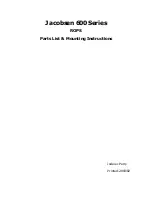
85058V
3-3
Use, Maintenance, and Care of the Devices
Visual Inspection
Visual Inspection
Visual inspection and, if necessary, cleaning should be done every time a connection is made.
Metal particles from the connector threads may fall into the connector when it is disconnected.
CAUTION
Devices with damaged connectors should be immediately discarded or clearly
marked and set aside for repair. A damaged device will in turn damage any good
connector to which it is attached. Determine the cause of the damage before
connecting a new, undamaged connector in the same configuration.
In some cases, magnification is necessary to see damage to a connector; a magnifying device
with a magnification of
10
is recommended. However, not all defects that are visible only
under magnification will affect the electrical performance of the connector. Use the following
guidelines when evaluating the integrity of a connector.
Look for Obvious Defects and Damage First
Examine the connectors first for obvious defects or damage: badly worn plating on the
connector interface, deformed threads or bent, broken, or misaligned center conductors.
Connector nuts should move smoothly and be free of burrs, loose metal particles, and rough
spots.
What Causes Connector Wear?
Connector wear is caused by connecting and disconnecting the devices. The more use a
connector gets, the faster it wears and degrades. The wear is greatly accelerated when
connectors are not kept clean, or are not connected properly.
Connector wear eventually degrades performance of the device. Verification devices should
have a long life if their use is on the order of a few times per week. Replace devices with worn
connectors.
The test port connectors on the PNA test set may have many connections each day, and are,
therefore, more subject to wear. It is recommended that an adapter be used as a test port saver
to minimize the wear on the test set’s test port connectors.
Connector Contacts
for visual guidelines when evaluating the contact integrity of a
connector.
NOTE
Notice the location of the cross hairs in relationship to the center of the figures.
Summary of Contents for 85058V
Page 1: ...Keysight Technologies 85058V 1 85 mm Verification Kit User s and Service Guide...
Page 2: ......
Page 3: ...85058V...
Page 7: ...1 General Information...
Page 12: ...1 6 85058V General Information Clarifying the Terminology of a Connector Interface...
Page 13: ...2 Specifications...
Page 20: ...2 8 85058V Specifications Electrical Specifications...
Page 21: ...3 Use Maintenance and Care of the Devices...
Page 36: ...3 16 85058V Use Maintenance and Care of the Devices Handling and Storage...
Page 37: ...4 Performance Verification...
Page 40: ...4 4 85058V Performance Verification Recertification...
Page 41: ...5 Troubleshooting...
Page 43: ...85058V 5 3 Troubleshooting Troubleshooting Process Figure 5 1 Troubleshooting Flowchart...
Page 47: ...6 Replaceable Parts...
Page 54: ...6 8 85058V Replaceable Parts Replaceable Parts...
















































